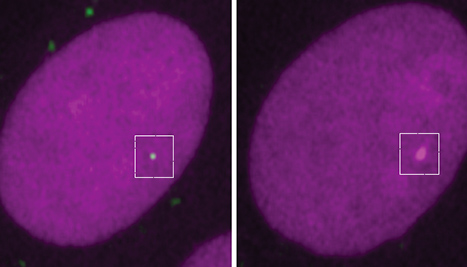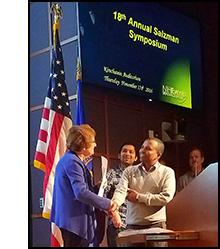Explore Dr. Pathak's past news.
Vinay Pathak Discussed HIV-1 Uncoating Discovery on PNAS Science Sessions Podcast
In a June 2021 interview on Science Sessions, the podcast program of the Proceedings of the National Academy of Sciences USA (PNAS), Vinay Pathak explained the story behind the HIV-1 uncoating discovery by his lab in collaboration with Wei-Shau Hu's research team, a groundbreaking advance that was awarded the 2020 PNAS Cozzarelli Prize in Biomedical Sciences. To listen to the podcast, click here.
Podcast Featured Vinay Pathak Discussing Live-Cell Imaging of HIV-1
Vinay Pathak was interviewed in a podcast by Consultant360 Specialty Network on the research presented in the "Navigating to the Nucleus" session at the Conference on Retroviruses and Opportunistic Infections 2021, including his presentation on "Live-Cell Imaging of HIV-1 Nuclear Import, Uncoating, and Proviruses." To listen to the podcast, click here.
PNAS Video on Cozzarelli Prize Awarded to Pathak and Hu Labs
In a video produced by Proceedings of the National Academy of Sciences USA (PNAS) about the 2020 Cozzarelli Prize in Biomedical Sciences, Vinay Pathak discusses the HIV-1 uncoating discovery by his research team in collaboration with Wei-Shau Hu’s lab. The video can be viewed on the PNAS Cozzarelli Prize page and on the PNAS YouTube channel (click here).
The publication that Dr. Pathak discusses in the video (“HIV-1 uncoats in the nucleus near sites of integration,” PNAS 117:5486-5493, 2020) was also featured on the website of the Center for Cancer Research, National Cancer Institute (“New study overturns conventional understanding of how HIV infection occurs”) and highlighted on the front cover of the Cold Spring Harbor 2020 Retroviruses Meeting abstract book.
PNAS Cozzarelli Prize Awarded to Pathak and Hu Labs
A recent study published by the research groups of Vinay Pathak and Wei-Shau Hu in Proceedings of the National Academy of Sciences USA (“HIV-1 uncoats in the nucleus near sites of integration,”
PNAS 117: 5486-5493, 2020) was awarded the 2020 Cozzarelli Prize in the class of Biomedical Sciences. The Cozzarelli Prize is awarded to just 6 papers chosen from nearly 4,000 published research articles, one in each of the 6 classes of the National Academy of Sciences. They represent the top scientific research published in PNAS in 2020. To read more about this award, click here.
Uncoating of an infectious HIV-1 complex is shown at left. Click on the figure for a full caption and here to download the original video (Movie S1 in the paper).
This study was also featured on the website of the Center for Cancer Research, National Cancer Institute (“New study overturns conventional understanding of how HIV infection occurs”) and highlighted on the front cover of the Cold Spring Harbor 2020 Retroviruses Meeting abstract book.
Research by Pathak and Hu Labs Featured on Cover of 2020 Retroviruses Meeting Abstract Book
A recent study published by the research groups of Vinay Pathak and Wei-Shau Hu in Proceedings of the National Academy of Sciences USA (“HIV-1 uncoats in the nucleus near sites of integration,” PNAS 117:5486-5493, 2020) was featured on the front cover of the Cold Spring Harbor Laboratory 2020 Retroviruses Meeting abstract book. Pathak lab member Ryan Burdick launched the meeting with his talk on the study and reported that HIV-1 uncoats in the nucleus near sites of integration. Contrary to the prevailing theory for more than 40 years that retroviral uncoating occurs in the cytoplasm, the study team showed that HIV-1 cores are essentially intact as they enter the nucleus, where they complete reverse transcription before uncoating near their sites of integration into the host genome. These unexpected results fundamentally alter the current understanding of HIV-1 replication, which could lead to the development of more effective strategies and drugs for the treatment of HIV infections.
In the cover image, the left panel shows an HIV-1 capsid localized in the nucleus and the right panel shows a site of transcription of the viral genome at the site where the capsid localized. To read more about the study, see the original research article and the commentary "Entering and breaking for HIV?" in Nature Reviews Microbiology.
This study was also awarded the 2020 PNAS Cozzarelli Prize in Biomedical Sciences and featured on the website of the Center for Cancer Research, National Cancer Institute (“New study overturns conventional understanding of how HIV infection occurs”).
CCR News Feature about HIV-1 Infection Study by Pathak and Hu Labs
[Excerpted from a 26 February 2020 news feature by Center for Cancer Research (CCR), National Cancer Institute]
New Study Overturns Conventional Understanding of How HIV Infection Occurs
With unprecedented detail, researchers have observed where and when the protective casing around the human immunodeficiency virus (HIV-1) is shed inside a human cell, which is an observation that overturns the conventional understanding of how the virus infects cells and replicates. The finding was published February 24, 2020, in the Proceedings of the National Academy of Sciences (PNAS) USA.
“Understanding how HIV-1 replication occurs can provide valuable insights into essential interactions between the virus and the host cell,” explains Vinay K. Pathak, Ph.D., Senior Investigator in the Retroviral Replication Laboratory, part of the HIV Dynamics and Replication Program.
Despite the importance of understanding how the virus infects human cells, many details about this process have remained unknown. Until now, many scientists suspected that the protective casing around the virus, called the viral capsid, was shed before the virus enters the center of a human cell, called the nucleus. Once inside the nucleus, the virus begins to replicate itself.
Pathak’s lab used a new approach to brightly label the viral capsid with fluorescence in order to track it. Previous efforts to label the viral capsid with fluorescent proteins resulted in dimly labeled or defective viruses, making it difficult to study the uncoating process.
Unexpectedly, they found that the viral capsid remained essentially intact after entering the nuclei of cells. They also identified a key protein called CPSF6 that helps facilitate the transport of the virus, including its capsid, through the pores of a nucleus.
“We hope that the insights gained in our studies will help to identify critical molecular interactions between the virus and the host that will facilitate the development of new classes of potent anti-retroviral drugs,” says Pathak.
However, he notes, this study raises many unanswered questions. It’s still a mystery, for example, on how the full virus (capsid included) at a diameter of roughly 61 nanometers can squeeze through the pore of a human nucleus, which is only about 39 nanometers wide. More research is needed to understand how this happens and to identify the mechanisms that help trigger the virus’s uncoating process.

Confocal image of an infected cell nucleus (purple) shows an HIV-1 capsid core (green spot, left panel) just before uncoating and a transcriptionally active provirus (bright purple spot, right panel) that appears several hours later near the site of uncoating. Image credit: Ryan C. Burdick
[This study was also awarded the 2020 PNAS Cozzarelli Prize in Biomedical Sciences and highlighted on the front cover of the Cold Spring Harbor 2020 Retroviruses Meeting abstract book.]
Travel Award, CCR and DCEG Staff Scientist and Staff Clinician Retreat
Krista Delviks-Frankenberry received a $1,500 travel award for the best oral presentation at the 14th Annual CCR and DCEG Staff Scientist and Staff Clinician Retreat in April 2018.
Norman P. Salzman Memorial Poster Award in Virology
Belete Desimmie won a 2016 Norman P. Salzman Memorial Poster Award in Virology for his work on APOBEC3 inhibition of HIV-1 replication. This annual NIH-wide award is given to three postdoctoral fellows per year to recognize outstanding research in the field of virology under the mentorship of an NIH, CBER, or Leidos scientist. Postdoctoral fellows from all NIH campuses, including Bethesda and Frederick, can apply for the award. Dr. Desimmie presented his poster at the 18th Annual Norman P. Salzman Virology Symposium in November 2016 and received a cash award for his achievement.
Poster Awards, Spring Research Festival at NCI-Frederick
Taisuke Izumi won a poster award for his presentation at the 2013 NCI-Frederick Spring Research Festival. Members of the Pathak lab who won poster awards at the Spring Research Festival in previous years include Tobias Paprotka (2011), Krista Delviks-Frankenberry (2007), Rebecca Russell (2007), Patricia Henry (2006), Galina Nikolenko (2006), and Hongzhan Xu (2006).
2013 Awards from Frederick County Science & Engineering Fair
In 2013, Catoctin High School senior Maria Hamscher presented the research she has been conducting in the Pathak lab at the 32nd Annual Frederick County Science & Engineering Fair in Frederick, Maryland. Maria won the 2nd Place Award in Cellular & Molecular Biology, High School Division and also a Distinguishing Achievement 2nd Place Award, given by the Commissioned Officers Association of the U.S. Public Health Service, for her research entitled "Testing the P2A Cleavage System for Gene Therapy Vectors." Since July 2012, she has been working as a Werner H. Kirsten Student Intern in the Pathak lab under the mentorship of Krista Delviks-Frankenberry.
NIH Asian and Pacific Islander American Organization Award
Vinay Pathak was the recipient of the 2012 NIH Asian and Pacific Islander American Organization (APAO) Award for outstanding accomplishments in biomedical research. Each year, the APAO honors two outstanding individuals in the NIH Asian and Pacific American community: one for Scientific Achievement, recognizing scientists who have made significant accomplishments in biomedical research; and the second for Leadership Excellence, recognizing non-scientists who exemplify leadership excellence by example, mentorship, and empowerment of Asian and Pacific Americans to promote diversity and support the overall mission of NIH. Dr. Pathak received his Scientific Achievement award at the NIH APAO annual awards ceremony in December 2012.
Award from U.S.-Russia Joint Working Group on Biomedical Research Cooperation
In 2012, Vinay Pathak was the recipient of one of the five grants that the U.S.-Russia Joint Working Group on Biomedical Research Cooperation awarded to National Cancer Institute intramural investigators for their highly meritorious research applications. Dr. Pathak is the Principal Investigator on a project focused on characterizing broadly neutralizing antibodies by phage display peptide libraries.
Norman P. Salzman Memorial Award in Virology
Tobias Paprotka won the 2011 Norman P. Salzman Memorial Award in Virology for his work on XMRV. This annual NIH-wide award is given to only one postdoctoral fellow per year to recognize outstanding research in the field of virology under the mentorship of an NIH, Center for Biologics Evaluation and Research, or SAIC scientist. Postdoctoral fellows from all NIH campuses, including Bethesda and Frederick, can apply for the award. Dr. Paprotka presented his research at the Thirteenth Annual Norman P. Salzman Memorial Symposium in Virology on November 10, 2011 and received a plaque and a cash award for his achievement. As Dr. Paprotka's mentor, Vinay Pathak also received a plaque at the Symposium.
Postdoctoral Fellowship, Japan Society for the Promotion of Science
Taisuke Izumi was awarded a Postdoctoral Fellowship from 2011 to 2013 by the Japan Society for the Promotion of Science. The fellowship program sponsored by this society supports meritorious biomedical research projects undertaken in NIH laboratories by Japanese postdoctoral researchers. Fellowships are awarded after a competitive review of research proposals.
Scholarship Award, Keystone Symposia on HIV Pathogenesis
Rebecca Russell was awarded a travel scholarship to present her research findings at the 2008 Keystone Symposia on HIV Pathogenesis.
2006 Travel Fellowship, HIV & Cancer Virology Faculty, Center for Cancer Research
In 2006, Jean L. Mbisa won one of the three available travel fellowships awarded by the HIV & Cancer Virology Faculty, Center for Cancer Research, National Cancer Institute.



